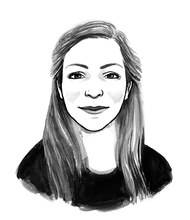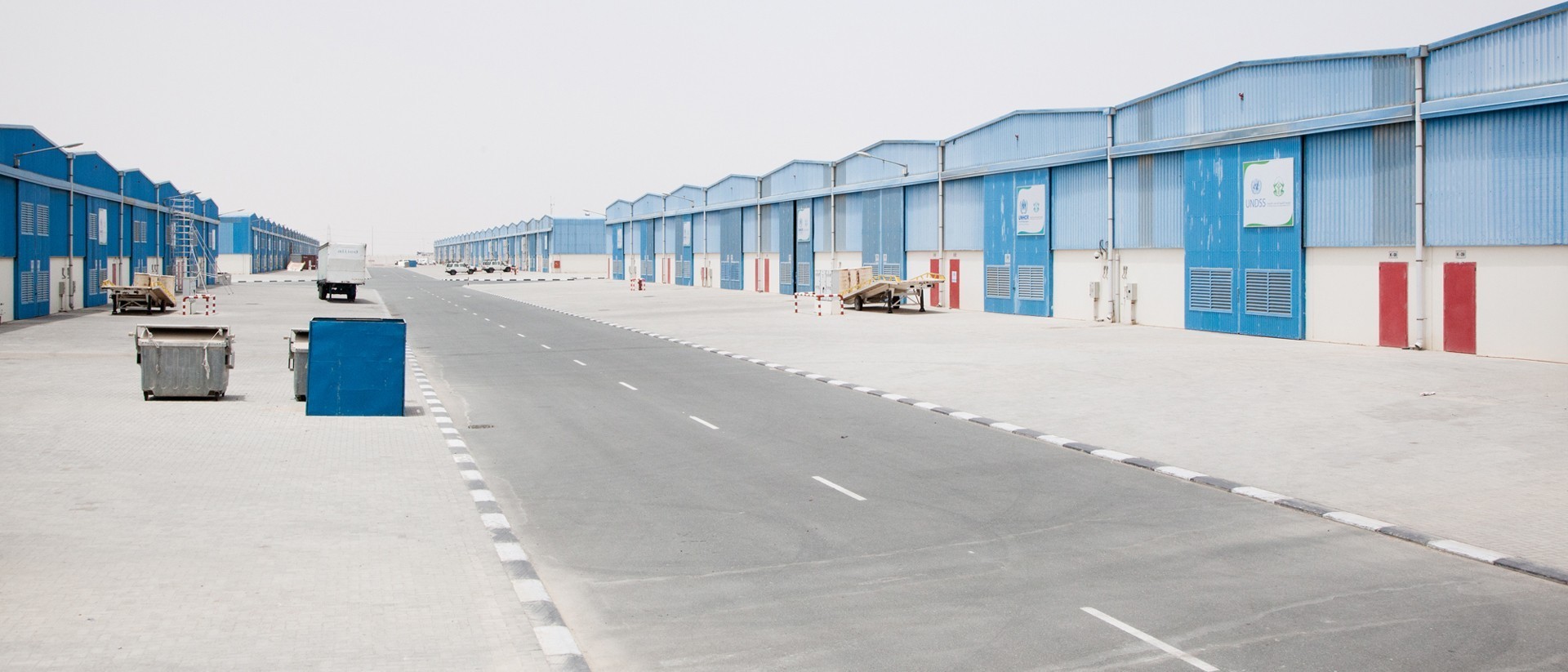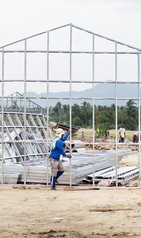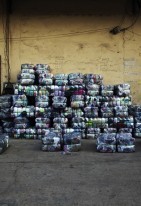A brand new strip of asphalt cuts straight into the desert of the United Arab Emirates, as far as the eye can see. The Dubai skyline shrinks in the rearview mirror, and the countless skyscrapers, like so many bolting plants, soon fade in the dusty air.
All color is washed out by the sand and sun. It’s not yet summer, but outside the mercury has already topped 100 degrees. Along the road, there’s nothing but gray desert scrub, power lines, and the occasional camel. The miles tick away on the odometer.
Suddenly, an oasis of palm trees, fountains, and shimmering glass appears. The top of the main building reads in capital letters: International Humanitarian City. It may seem an unlikely location, but since last year, the IHC is officially the largest logistics center for emergency relief supplies in the world.
Tons of emergency supplies are stored here – hundreds of thousands of tons – awaiting the world’s next big disaster: blankets, tents, buckets, soap, tarps, toothbrushes, mosquito nets, medical supplies and pharmaceuticals, but also bulletproof vests, vehicles, bodybags, generators, and water treatment equipment.
The facilities include some 560,000 square feet of storage (about ten football fields), filled with 30-foot-high shelving units, plus another 107,000 square feet of office space (two football fields). Last year, over 70% of humanitarian aid for Syria was sent from Dubai.
And the humanitarian community gets all of this at no charge – absolutely free – compliments of the government. That makes the United Arab Emirates unique: a country that not only donates money and supplies to humanitarian aid organizations, but also makes available space, manpower, and convenient customs arrangements to facilitate the swift import and export of humanitarian goods. But how does that work? And what’s in it for Dubai?
The IHC offices. Pieter van den Boogert for The Correspondent

The vision of His Highness
The United Arab Emirates is a young country. The union of seven emirates turns 42 next year. Just decades ago, the Emirati people were pearl fishers and date traders; now they live in one of the fastest-growing economies in the world.
The UAE has pumped its oil and gas revenues into the country’s hypermodern infrastructure. Dubai boasts the largest port between Rotterdam and Singapore and the world’s largest tax-free zone. Dubai wants to become the center of the world.
Illustration by Momkai

"Everything you see here is years in the making, a carefully thought-out strategy devised by the country’s leaders," says Julien Chauvelle, Supply Unit Manager at the Dubai offices of Doctors without Borders. From the car, he points out a giant mural depicting the current prime minister, the emir of Dubai. "This sort of strategy can easily be adhered to in an autocracy. And even more so if you have such a small population."
Although the UAE is home to some 9 million residents, only 1 million are Emirati. The vast majority are foreign nationals. "The Emirati people get everything they want from the government," Chauvelle says. "Don’t get me wrong, this is certainly a dictatorship. But the Emirati are happy. They have no need for democracy; they already have it all."
But simply being a center for business was not enough for UAE leaders. The Emirates want to be the center of the humanitarian world, too. "The wealthy should give to the poor," the first president of the UAE Sheikh Zayed bin Sultan al-Nahyan is often quoted as saying. In power until his death in 2004, he believed, "God has given us this fortune to develop our nation and contribute to the development of less fortunate countries."
And the UAE would seem to be putting its money where its mouth is. As of this year, the United Arab Emirates is the world’s biggest provider of foreign aid, relative to its gross national income.
And the Emirati went a step further: In 2007, a law was issued by the ruler of Dubai, Sheikh Mohammed bin Rashid al-Maktoum, which declared a humanitarian ‘city’ was to be founded, an undertaking fully financed by the government to help humanitarian aid organizations. United Nations aid organizations would be able to make use of all storage and office facilities in the International Humanitarian City free of charge; NGOs would be charged at cost. The new location was completed in 2011.
A trailer full of UNHCR tents, intended for refugees along the border between Ethiopia and South Sudan. Pieter van den Boogert for The Correspondent
Vehicle fleet of the International Federation of Red Cross and Red Crescent Societies, ready for transport to a disaster area. Pieter van den Boogert for The Correspondent

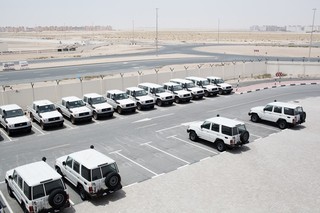
The advantages of Dubai
In the lobby of the International Humanitarian City building, you are greeted by the air conditioning, the sound of two fountains, and nine security guards. The marble floor sparkles and gleams. The chic offices of the aid organizations are scarcely used. The real work takes place a 10-minute drive down the road – a straight strip of asphalt through the desert – in a complex of low, blue warehouses.
The supply offices of the IHC’s three largest aid organizations are right next door to one another: the United Nations Refugee Agency (UNHCR), the International Federation of the Red Cross (IFRC), and the U.N. World Food Program. The UNHCR, for example, stores half of all its global supplies here – enough to provide 350,000 people worldwide with the most basic necessities within 24 hours. In the event of a major disaster, the first relief supplies from all three organizations always come from Dubai.
In the event of a major disaster, the first relief supplies always come from Dubai.
The International Humanitarian City now has a total of 55 partner organizations that make use of its services. Partners include U.N. agencies, NGOs and private companies, many of which were already located in Dubai before the IHC was set up.
Dubai is located where three continents meet – perfect for responding swiftly to disasters around the world. Two-thirds of the globe can be reached by air in eight hours or less. Dubai has a huge port, seven airports, and an excellent infrastructure, making it an ideal logistics hub, which in turn attracts numerous service providers. This competitive market keeps prices down. Fuel costs are low and planes always available. And it’s easier to arrange a visa here for many Middle Eastern nations than from other places.
Add to that the generous government support. In addition to free facilities – warehouses, offices, conference rooms, as well as the considerable utility costs of cooling buildings in the desert climate – aid organizations are also exempt from import and export duties. And the IHC arranges discounts with hotels and airlines for international aid workers.
Lines of communication with the government are shorter than short. Until recently, the CEO of IHC worked for the wife of the ruler of Dubai. "For us, the situation in Dubai works very well at a practical level," admits Soliman Daud of the UNHCR. "You’ve got a small group of highly educated people at the helm, who are all deeply concerned about the humanitarian world. If we need something from the government, we get it."
In the past five years, UAE leaders have pumped 135 million Emirati dirham ($37 million) into the IHC. Last year alone, investments totaled 60 million dirham ($16 million).
IFRC tarps in the Red Cross storage facility in Dubai. Pieter van den Boogert for The Correspondent
The UNHCR warehouses in Dubai. Pieter van den Boogert for The Correspondent

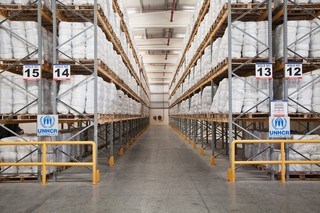
Too good to be true?
It all sounds a little too good to be true. The act of giving is noble, to be sure, but are there other reasons for Dubai’s generosity? What’s in it for Dubai?
CEO Shaima al-Zarooni – jet black mascara, pastel pink lipstick, and a black head scarf, pushed back just past her hairline – is seated in her office on a white leather couch, a sheepskin draped over the armrest. She takes a sip from an enormous mug of green tea. "Dubai wants to be the best at everything," she tells us. "That includes the humanitarian world."
"Our sheikh has a vision of Dubai becoming the humanitarian capital of the world." She points to his portrait on the wall. "And His Highness is unparalleled in making his vision reality."
The presence of the humanitarian giants attracts all kinds of commercial businesses to Dubai.
But why the humanitarian world? Is it about image? "We want to save lives," says Zarooni. "But yes, the IHC is important for Dubai’s image. We are an Islamic country, and there is a lot of tension in the world regarding muslims. But giving to the poor is very much a part of Islamic culture. This kind of philanthropic institution helps boost our reputation." Above all, the Emirates want to show that they are not only about economic gain. According to Zarooni, "Developed countries have an obligation to help."
Soliman Daud of the UNHCR sees many Arabic countries struggling to improve their international image. "Qatar has Al-Jazeera; Dubai has gone the humanitarian route," he explains.
But Dubai wouldn’t be Dubai if it didn’t also affix a business model to the IHC. The presence of humanitarian giants attracts a range of commercial businesses to Dubai, which then provide goods and services to the aid organizations. These companies create jobs and pay taxes. And the UNHCR, for example, purchased $50 million of goods in the United Arab Emirates last year alone.
Land Rovers being prepped for the field in the IFRC garage in Dubai. Pieter van den Boogert for The Correspondent
Left: Goran Zuber of the IFRC in Dubai. Right: Julien Chauvelle of Doctors without Borders in Dubai. Pieter van den Boogert for The Correspondent
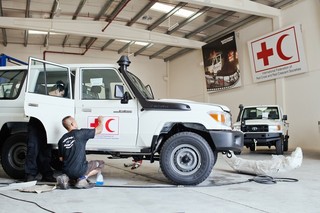

Immigrants in Dubai
A striking fact about Dubai as a center for world humanitarian relief is that many residents are foreign nationals from countries that receive relief aid on a regular basis. The largest portion of the UAE population – over 42% – are foreign workers from Southeast Asia: Bengalis, Filipinos, Indians, Pakistanis. They have been recruited by special agencies in their home countries to come work in Dubai.
Most of these foreign nationals work in construction, building new infrastructure, but others work in the aid organization warehouses, for instance. Alarming news about the working and living conditions they face has already reached the outside world. Are the aid organizations treating their own employees humanely?
Some workers in the camps sleep five to a room.
Julien Chauvelle from Doctors without Borders manages supplies here which can provide humanitarian assistance to some 11,000 families. From his car, he points out a group of housing blocks surrounded by a high fence. The apartments look like stacked jail cells, their small windows the only feature on the high concrete walls. Inside the perimeter, there are small parks, where groups of Bengalis sit together in the grass. This is a ‘worker camp,’ where the migrants who work in the tax-free zone live. Some sleep five to a room here.
Chauvelle relays how difficult is it to know whether the employees are treated well. "Especially in the beginning, that was really hard for me. I mean, if someone earns five dollars a day, that may be a lot to them. But where do you draw the line?"
Chauvelle sighs. "Of course we look out for the folks who work in our warehouse. We check to see if people are smiling on the workfloor; we go check out the camps they live in. We don’t want any headlines about how we’re taking advantage of people instead of helping them. But if I arrange a road shipment, how much do I really know about the truck driver’s personal situation? Or if I need to quickly hire new people to respond to a particular disaster, how am I supposed to assess all of their living conditions first?"
It is difficult to shed much light on the dark side of Dubai.
IHC conference room in Dubai. Aid organizations can use these rooms at no charge. Pieter van den Boogert for The Correspondent
Auditorium in de IHC. On the wall, portraits of UAE leaders. Pieter van den Boogert for The Correspondent

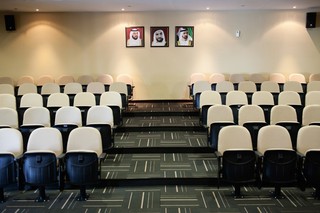
Working together closely or simply working close together?
And that is not the only gray area. In February of last year, U.N. Secretary-General Ban Ki-Moon visited the International Humanitarian City, hailing it as a "striking example of how the international community can address global aid and development challenges more effectively by closely cooperating." But do IHC organizations truly work together?
In practice, that does not appear to be the case. "We all know each other. The warehouses are all grouped close together," explains Goran Zuber of the IFRC. "We coordinate lots of things informally, but there’s no structural cooperation. Each organization operates independently." While the organizations may have the same goal and send humanitarian aid to the same areas in the world, they remain competitors, chasing after funding from the same donors.
This is evident in the warehouses, too. Every organization has the same sorts of supplies: blankets, tarps, tents, etc. Every organization has its own forklifts and other warehouse equipment. Every organization has its own garage, to prep vehicles of the same makes and models as every other organization for use in the same disaster areas. On occasion, transport flights may be combined, or storage space shared, but that’s the extent of the cooperation – an opportunity missed.
Left: Soliman Daud of the UNHCR in Dubai. Right: Shaima Al-Zarooni, CEO of the IHC in Dubai. Pieter van den Boogert for The Correspondent
The IFRC offices in the IHC. Pieter van den Boogert for The Correspondent
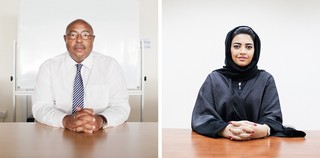
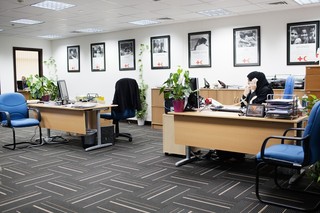
Not everyone wants to take part
Despite the sweeping plans, the IHC offices are far from the bustling meeting place you would expect from the "humanitarian capital of the world." A tent manufacturer says that they have an office in the IHC but cannot find anyone to staff it. No one wants to work there because it is too remote. And yet here and there, construction cranes are starting to dot the horizon. For the World Expo in 2020, a whole new section of the city is being built from the ground up.
There are also aid organizations who refuse to work in the IHC. Doctors without Borders has offices in Dubai because of the city’s strategic location, but works outside the IHC on principle. After all, the IHC remains a state institution. As Julien Chauvelle explains, "We want to maintain our independence as an aid organization. And we cannot reconcile that with accepting government gifts of this kind."
CEO Zarooni emphasizes that the IHC is a neutral agency. "There are certainly no strings attached." But when it comes to the IHC’s plans for the future, it suddenly becomes clear just how enmeshed the UAE dictatorship and the IHC are.
"We are currently developing a five-year-plan," says Zarooni, smiling. What that plan involves? She glances nervously at the IHC spokesperson. "I’m not at liberty to discuss that. It involves strategy and has not yet been approved by our leaders."
Waiting area in the lobby of the IHC office building. Pieter van den Boogert for The Correspondent
A UNHCR tent, set up to serve as a showroom model. Pieter van den Boogert for The Correspondent


Would you rather read this article in Dutch?
This series was made possible in part by grants from the Dutch Foundation for Special Journalism Projects and from the National Postcode Lottery Fund for Journalists, awarded by Free Press Unlimited.
